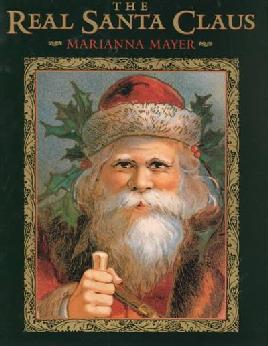As a toddler, Young Lady was terrified of Santa. Not only did she want nothing to do with the Mall Santa, she was scared to got sleep on Christmas Eve, afraid of the strange man in a red suit who might come into our house in the night while we’re sleeping.
“How about if Mummy and Daddy fill your stocking and just pretend its Santa?” I suggested. She nodded eagerly, snuggled under her blanket and was asleep within minutes.
Several years later, a few days before Christmas, I was driving with a 7 year old Young Lady in the car with me.
“Santa’s not real, is he?” she said suddenly, “It’s just you and Daddy pretending.”
“Actually,” I answered her, “He was a real person. His name was Nicholas, and he was a bishop of a town called Myra many hundreds of years ago.” I then told her what I could remember off the top of my head of the story of the original Saint Nicholas (as summarised by Gary Hansen in his post here).
Her eyes grew wide, her little mouth dropped open, “You mean he really is really real?”
 When we got home, I showed her in the Atlas (with a little help from Google) where Myra was (yes, that is a very long way from the North Pole). We found this beautifully illustrated book at the library which told more of the stories of Saint Nicholas.
When we got home, I showed her in the Atlas (with a little help from Google) where Myra was (yes, that is a very long way from the North Pole). We found this beautifully illustrated book at the library which told more of the stories of Saint Nicholas.
I found it tragic that a Vicar in the UK got into trouble for telling the story of Saint Nicholas to a group of children. When I read some of the comments of the complaining parents that were quoted in the report, my first reaction was you can’t be serious! Either this is some over-reactive attention seeking, or these parents have missed the whole point completely! (Remember, there was this baby, who was put to sleep in a manger because there was no room in an inn…)
My own experience with my children has been that the original story of Nicolas has added to the awe and wonder and magic of Christmas, perhaps because it’s grounded in a real person (possibly some of the stories are slightly exaggerated by the distance of time) who lived in a real place (locatable on a map) in a real time (even if it was 1700 years ago).
I’ve told my children that even though Nicholas died a very long time ago, because he was so good and generous and kind and loving, that his Spirit has lived on and become part of the Magic of Christmas that is still alive today. Every time someone does something kind and generous in remembrance of Nicholas, they keep the spirit and magic of Nicolas alive. (Yes, that’s the same magic that fills children’s stockings with goodies on Christmas eve).
Stories like this one in my own neighbourhood: an anonymous benefactor has bought a HOUSE for a pensioner who would otherwise have been left homeless.
Or this story doing the rounds of Social Media:
Real stories, that happen in the here and now. Not just the big ones that hit the news headlines or go viral on the internet, but also the smaller, everyday random kindnesses by ordinary people. They are far more inspirational than the commercialised fantasy story involving flying reindeer and a sleigh full of expensive toys. (I wonder how much in royalties Hollywood has paid to Coca-Cola over the years for their use of their character?).
Here is the real magic of Christmas. Ordinary people can be inspired by the greatest gift of all that we remember at Christmas – that God himself came to make himself known to us as one of us. Ordinary people can demonstrate that love to others that was first shown to us through a child born 2013-ish years ago. Ordinary people keep that Spirit and Magic alive.
Sometimes the very best of stories are the ones that happen to have been true once upon a time.




